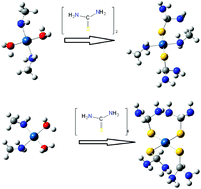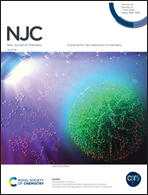A kinetic and mechanistic study of analogous bifunctional dialkylamine platinum(ii) complexes†
Abstract
This study was aimed at investigating the comparative substitution behaviour of analogous cis/trans-Pt(II) complexes with inert dialkylamine ligands. The rate of substitution of the aqua ligands by three nucleophiles, viz. thiourea (TU), 1,3-dimethylthiourea (DMTU) and 1,1,3,3-tetramethylthiourea (TMTU), for the complexes: [cis-Pt(OH2)2(NH3)2](ClO4)2 (cPt), [cis-Pt(OH2)2(NH2CH3)2](ClO4)2 (cPtM), [cis-Pt(OH2)2{NH2CH(CH3)2}2](ClO4)2 (cPtR), [trans-Pt(OH2)2(NH3)2](ClO4)2 (tPt), [trans-Pt(OH2)2(NH2CH3)2](ClO4)2 (tPtM) and [trans-Pt(OH2)2{NH2CH(CH3)2}2](ClO4)2 (tPtR) was investigated under pseudo first-order conditions as a function of concentration and temperature by stopped-flow and UV/visible spectrophotometry. The reactions of the cis-complexes proceed in two concerted steps whereas those of the trans-complexes followed a stepwise mechanism involving rate determining substitution of the first chloride followed by a fast second substitution step, with no intermediates being detected. The pseudo first-order rate constants, kobs obeyed the rate law: kobs = k2[nucleophile]. The trans-complexes were observed to be approximately 103 times more reactive than their corresponding cis-analogues. The electronic and the steric hindrance due to the geometries of the complexes controlled the overall reaction pattern. The order of reactivity of the complexes is tPt > tPtM > tPtR > cPt > cPtM > cPtR. The reactivity of the nucleophiles with the complexes decreases with an increase in steric demand in the order: TU > DMTU > TMTU. The trans-dialkylamine complexes formed distinctly different kinetic products relative to their cis-analogues. 195Pt NMR spectroscopic results confirmed the final kinetic products of each of the cis- and trans-complexes. The negative entropy of activation (ΔS≠) values in all the complexes investigated assert an associative substitution mechanism, with the mechanism being more pronounced in the cis-complexes than in their trans-analogues.



 Please wait while we load your content...
Please wait while we load your content...